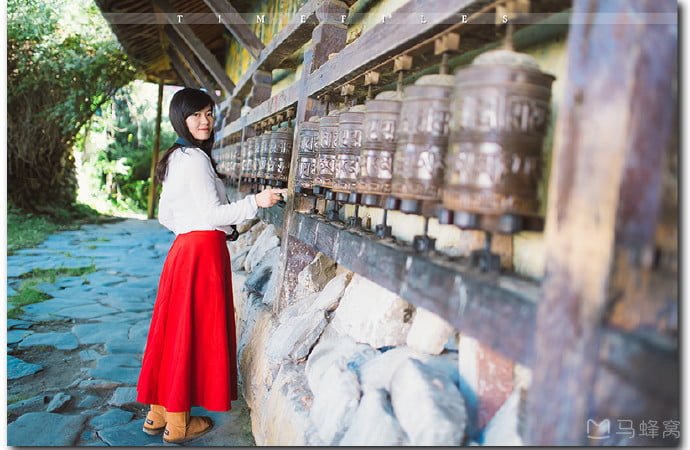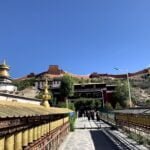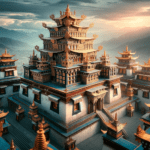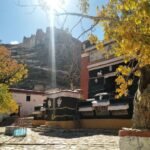Introduction to Gyirong Dzongga Choede Monastery
Dzongga Choede Monastery, རྫོང་དཀར་ཆོས་སྡེ། is a remarkable Tibetan Buddhist monastery located in the southern part of Gyirong County. It stands at an impressive altitude of 4050 meters. Other names is “Ngari Choe Ganden Phelgye Ling Temple”. The monastery has undergone a significant transition from the Nyingma to the Gelug sect of Tibetan Buddhism.
Architectural Layout of Gyirong Dzongga Choede Monastery
The monastery’s layout extends from east to west in a rectangular shape. It covers an area of 1800 square meters (60 meters long and 30 meters wide). It comprises several key structures including the forecourt, porch, main hall, pagoda hall, and additional auxiliary buildings.
The Forecourt
The forecourt is an open-air courtyard, measuring 232 square meters, and faces to east. It serves as a vital space for religious activities, especially during the annual event on the 29th day of the 12th month of the Tibetan calendar. It accommodate up to 90 monks for ceremonial dances.
The Porch
Located in the western part of the forecourt, the porch spans 48 square meters. It features four square columns and two round columns, with diameters of 40 cm and 20 cm, respectively. The porch houses intricate artworks, including paintings of the Four Heavenly Kings, the revered Tsongkhapa and his disciples, and Buddhist symbols like the “Eight Precious Things” and longevity patterns.
The Main Hall
The nearly square-shaped main hall, facing east, covers 480 square meters. Originally, 36 octagonal columns supported it, but now only 22 remain. Decorative carvings of auspicious clouds, lotus petals, and scroll patterns adorn it, along with animal figures such as birds, lions, and deer.
The south wall of the main hall once held a thousand Buddha figures carved in wood. Notable features include the embalmed bodies of the monastery’s founders and precious gold-plated statues of Sakyamuni Buddha and Panchen Lama. The walls also showcase wooden scripture cabinets containing valuable texts like the “Kangyur” and “Tengyur”.
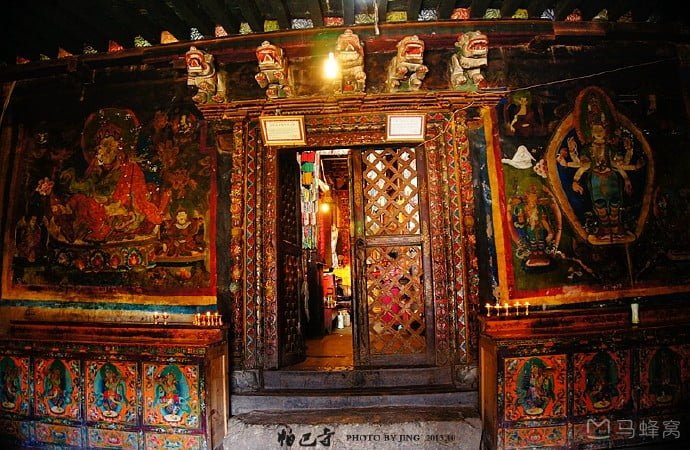
Murals of Gyirong Dzongga Choede Monastery
One of the monastery’s most exquisite features is its murals, predominantly found in the main hall. These murals depict various Buddhist deities, disciples, protective deities, and scenes of worship and music. All intricately designed with a backdrop of lotus flowers, auspicious clouds, Dharma wheels, and vajras.
East Wall Art
The eastern wall of Dzongga Choede Monastery showcases a variety of intricate Buddhist art. From the north end, the wall displays a depiction of the cycle of rebirth and twenty-one Taras. Notably, the most right-hand side features the protective deity Palden Lhamo with a blue body and three eyes, holding a spear in her right hand and a human-skin cover in her left, riding a yellow mule. Surrounding her are smaller deities, dragons, and the six-armed Yidam Gongbu Qiaxian, followed by fierce lions and other figures holding ritual instruments.
West Wall Main Figures
Rigsum Gonpo dominates the western wall’s central figures: Sakyamuni Buddha stands in the middle, Buddha to the left, and Sangye Woesung to the right. Paintings of revered figures like Milarepa, Tsongkhapa, and Amitayus Buddha grace the area above. Below, two disciples of Sangye Woesung wear yellow pointed hats and robes. The lower left corner features depictions of Tara in yellow and other deities.
Portraits of the Fifth Dalai Lama and other historical Dalai Lamas primarily decorate the north wall. The south wall showcases images of the main deity, Bodhisattvas, and Taras.
Second and Third Floor of the Main Hall
The second floor of the main hall contains 15 rooms, 5 of which were living quarters for monks and the rest serving as storage (“Nie Zhang”). The third floor has 18 rooms, with 7 as the main bedroom for the monastery’s leader and the rest as monk quarters. The upper structures have now collapsed, leaving only remnants with small windows.
Tashi Goma Pagoda Hall
Originally a three-story structure, the Tashi Goma Pagoda Hall’s ground floor was dedicated to the stupa. The doorway, 1.2 meters wide, features five layers of intricately carved designs including lotus, scrolls, lotus flowers, lion heads, and dragons. The hall is rectangular, measuring 133.28 square meters (13.6 meters long and 9.8 meters wide) and initially housed a large stupa, surrounded by over 200 gold-plated Buddha statues, which no longer exist.
Second Floor: Shyakang
The second floor, Shyakang, originally displayed sixteen Arhat gold-plated statues on the south wall. The south-west corner held gold-plated statues of the first to ninth abbots of the monastery. The central west wall was devoted to three Avalokiteshvara statues, one in gold and two in sandalwood, each about 2 meters tall, flanked by twenty-one Taras in gold-plated copper and sandalwood.
Third Floor: Protector Deities Chapel
The third floor primarily serves as a chapel for protector deities. It includes three rooms: one in the northwest corner enshrines the embalmed body of Lajen Quebasangbo, in a seated meditative pose with a yellow monk’s hat and gold robe, holding a vajra bell and dorje. Another room hosts life-sized clay statues of protector deities Gongbu, Langsei, and Lama. The Tashi Goma’s pinnacle originally featured a golden top, adding to the monastery’s grandeur.
Dzongga Choede Monastery: Historical Structures and Artifacts
Dongsha Lhakang: The Storage and Meeting Place
Located in the northwest corner of the main hall, Dongsha Lhakang was originally a three-story building made of stone and adobe. The ground floor contained four rooms, all used as storage spaces. The upper floor, known as Laji Kang, served as a meeting place for stewards and other officials. It housed the iron rod Lama’s residence, a small servant’s room, and a small chapel with 35 clay statues. This structure no longer exists.
Labrang: Residence for Prominent Lamas
Situated to the west of the main hall, La Burong was originally a two-story building serving as residences for Lamas of high status. It had a total of 10 rooms across both floors, with the southwest corner of the lower floor designated as the “Shenpo’s” living area and the north side as the residence of Khenpo Lajen Quebasangbo. This area once housed over 100 gold-plated Buddha statues.
Monastery’s History
Before the democratic reforms in Tibet, Dzongga Choede Monastery housed 93 monks. In 1959, parts of the monastery were destroyed, and it was completely abandoned during the Cultural Revolution. In 2014, a new Buddhist hall and three monk quarters were rebuilt on the site, covering approximately 150 square meters. The hall now houses several precious artifacts, including copper Buddha statues and cymbals from the original monastery.
Notable Artifacts of Gyirong Dzongga Choede Monastery
- Wooden Peacock Sculpture: Measuring 1.2 meters in length, 0.9 meters in width, and 0.6 meters in height, this sculpture features a peacock with a long, elegant tail, turned head, and detailed plumage. The shallow relief carving demonstrates a refined and ancient technique.
- Wooden Shakyamuni Vajra Statue: Standing 20 cm tall and 14 cm wide, this four-faced and twelve-armed deity embraces his consort, Vajra Hevajra (Dorje Pam), and stands on a prostrate figure. The statue is set on a lotus base surrounded by flames, showcasing the deity’s wrathful aspect.
- Xuande Era Cymbals: Two pairs of cymbals from the Xuande period of the Ming Dynasty. The larger pair has an outer diameter of 42 cm and features dragons and a flaming pearl design, along with the inscription “Made with gold and silver in the fifth year of the Xuande era of the Great Ming”.
- Dorje Semba Gold-plated Bronze Statue: This 41 cm tall statue, cast in bronze and gold-plated, depicts the four-faced, three-eyed, twelve-armed deity in an angry pose, trampling small demons.
- Marpa Gold-plated Bronze Statue: A 40 cm tall statue of Marpa (1012-1097), a founder of the Kagyu school, wearing monk’s robes and seated in a meditative pose on a double lotus pedestal.
- Medicine King Gold-plated Bronze Statue: At 54.5 cm tall, this statue represents the Medicine King, an embodiment of compassion and healing, seated in meditation with a herb in hand.
- Dorje Chang Gold-plated Bronze Statue: Standing 63 cm tall, this beautifully crafted statue shows the deity with crossed arms in a meditative pose, adorned with a lotus crown and jewelry, illustrating a blend of grace and power.
Visitor Information
- Tickets: Free admission.
- Opening Hours: 9:00 am to 5:00 pm.
- Access: Visitors can drive, hire a car, or walk to the monastery.

